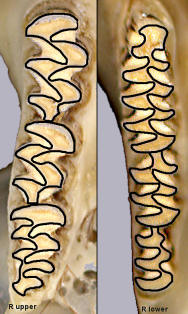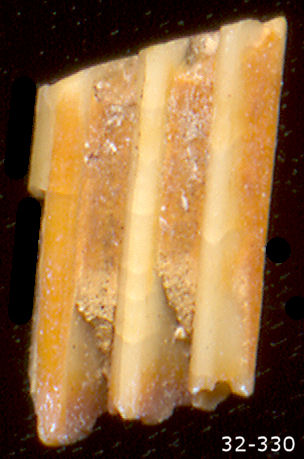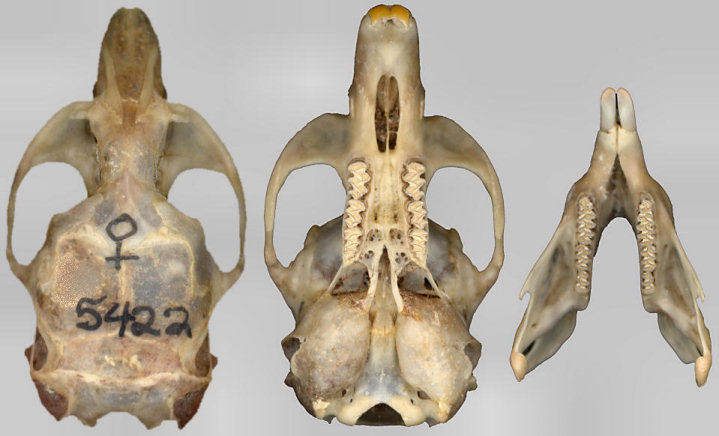Class Mammalia
Order Rodentia
Family Cricetidae
Subfamily Arvicolinae
Allophaiomys—Allophaiomys Voles // Lasiopodomys morphotype—Lasiopodomys-like Vole // Lemmiscus curtatus—Sagebrush Vole // Microtus—Meadow Voles // Mictomys—Mictomys // Mimomys—Water Voles // Myodes—Boreal Red-backed Vole // Ondatra sp.—Muskrats // Ondatra idahoensis—Idaho Muskrat // Ondatra zibethicus—Common Muskrat // Ophiomys parvus—Small Snake River Vole // Phenacomys intermedius—Western Heather Vole // Pliophenacomys primaevus—Primeval Vole // Synaptomys cooperi—Southern Bog Lemming

 The
arvicolines include a large number of cricetids that have prismatic teeth (Fig. 1).
Such teeth have a large number of enamel ridges (due to the dentine and cement wearing
more rapidly than the very hard enamel); as the upper and lower teeth move back and
forth, grasses or other fibrous plant material is caught between upper and lower ridges
and plant material is sheared, much as paper between the blades of scissors.
Arvicolines mostly feed on foliage, with some worthy of the
name "grazer." Grazers rely on grasses as major components of their diet;
extremely abrasive, grass wears teeth rapidly, presumably responsible for the
widespread occurrence of hypselodonty (Fig. 2) among the voles. A few, such as the
heather voles and muskrats, have rooted teeth that are only hypsodont.
The
arvicolines include a large number of cricetids that have prismatic teeth (Fig. 1).
Such teeth have a large number of enamel ridges (due to the dentine and cement wearing
more rapidly than the very hard enamel); as the upper and lower teeth move back and
forth, grasses or other fibrous plant material is caught between upper and lower ridges
and plant material is sheared, much as paper between the blades of scissors.
Arvicolines mostly feed on foliage, with some worthy of the
name "grazer." Grazers rely on grasses as major components of their diet;
extremely abrasive, grass wears teeth rapidly, presumably responsible for the
widespread occurrence of hypselodonty (Fig. 2) among the voles. A few, such as the
heather voles and muskrats, have rooted teeth that are only hypsodont.
Fig. 1 (upper left). Upper and lower right toothrows of Microtus. Enamel is outlined in black. Tooth material within the enamel is dentine; the light material outside of the enamel is cement.
Many arvicolines make runways through grass; the grassy covering above tends to help conceal them from predatory birds, and most utilize burrows for protection. Many species are active both diurnally and nocturnally. Since none of the regional voles is known to venture into caves, most or all fossil voles found in caves were deposited there by predators or washed in from the surrounding area.
Fig. 2 (upper right). Side view of a Microtus hypselodont second molar. The occlusal surface is at the top. In life, much of the tooth is embedded in the jaw, with the tooth pushed out by addition at the rootless end as the occlusal surface wears away. Fossil from Howell's Ridge Cave.
Each species of vole has preferred habitat, allowing interpretation of environmental conditions at the time of deposition (keeping in mind, of course, that inhabitants of several habitats may end up in the same deposit and that individual species may overlap even on a microgeographic basis).

Fig. 3. Dorsal and ventral views of the skull of a typical arvicoline rodent (Microtus mogollonensis), together with a dorsal view of the lower mandible. Note the appearance of prismatic cheekteeth. Despite the look of the toothrow, each row consists of only three molars.
Last Update: 2 Apr 2014